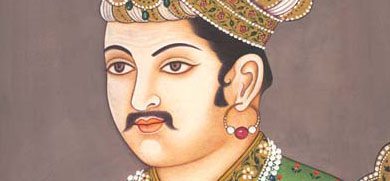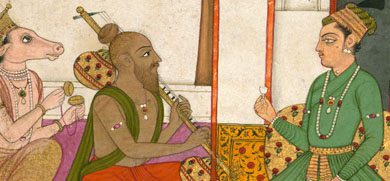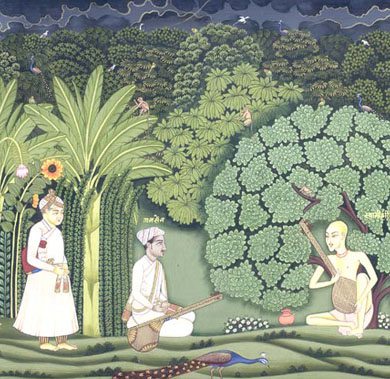This happened nearly 400 years ago. It is a wonderful and thrilling incident of the memorable meeting of Baiju Bavara, the supreme musician who Hotels a matchless position among accomplished musicians and Tanasena, the court musician of the Mogul Emperor Akbar.
Under the pretext of beating the world as a musician, Tanasena set out from Bangogadha (Rajasthana) in search of Baiju Bavara, the senior disciple of his guru Haridasa,went to various royal courts and defeated the musicians there. But nowhere did he find Baiju Bavari. At last Tanasena reached Agra and challenged the court musicians of Akbar, the Mogul Emperor of Delhi. But the court musicians of Delhi had not the courage to compete with Tanasena, who had natural talent, musical aptitude etc. Emperor Akbar confessed the weakness of his singers and with open heart he accepted the supremacy of Tanasena. He made him his court musician.
But Tanasena was still uneasy because he had not yet succeeded in his aim of beating the world as a musician.
But when Baiju came to know of Tanasena’s craze of beating the world in music, his sentiments as an artist were greatly hurt. He made up his mind to humiliate Tanasena and challenged him and according to the order of Emperor Akbar, arrangements for an extraordinary musical competition between them were made in the garden near the city Agra. It was a fine morning that filled the mind with joy. The atmosphere of the garden was also full of natural beauty. It was filled with soft and sweet sounds of birds. The musical competition was to begin in this charming atmosphere.
Emperor Akbar, his queens, the nine gems of Akbar’a court and fanatic admirers of music – all came to the garden. There came a musician, wrapped in tattered and old clothes and equipped with only a stringed musical instrument (Tanapuro). Tanasena. the court musician, was astonished to see his strange appearance. He was Baiju himself. Since they were not familiar, the two disciples of the same guru did not recognize each other. Still however, Tanasena had great fascination and high regards for him.

The competition started.
According to the order of the emperor, Tanasena first sang in the Todi mode and filled the atmosphere with music. Soon a small flock of deer fascinated by the music, came to Tanasena and stood there. Tanasena put a garland around the neck of a deer fascinated by music. As soon as the music was over, the deer frightened of the human crowd, ran away into the forest.
Baiju cheerfully looked at Emperor Akbar and said,” O, Sovereign! Tanasena sang in the Todi mode, fascinated the deer and called them here from the forest. Now I shall sing in the Mrgaranjani mode. Under the influence of this mode, only that deer will come which has the garland around its neck.” The Emperor allowed Baiju to sing in the Mrgaranjani mode. As soon as Baiju tuned his voice, the deer around whose neck Tanasena had put the garland, came running from the forest and sat by Baiju’s feet as if it were familiar since long, as if it were tame. Baiju took the garland of the deer’s neck and gave it to Emperor Akbar.

Then the Emperor asked Baiju to sing something else and expected to be answered by Tanasena.
Baiju then said, “O, Emperor! I shall now sing the Malakaumsa mode. Under its influence the stone lying in the front, will melt like wax and I shall put my stringed musical instrument into it. When the music will be over, the melted stone will again solidify. Let Tanasena take my stringed musical instrument out without breaking the stone.
The audience was astonished to hear this.
With full concentration, Baiju began to sing in the Malakaumsa mode and soon the stone began to melt. The stone completely melted into a liquid form. As soon as Baiju went to put his stringed musical instrument into it, Tanasena stood up and knelt at the feet of Baiju. With great respect and high regards he said, “According to what my guru said to me, there is a greater singer than I am. He is my guru’s disciple and senior to me. His name is Baijunatha. Who are you?”
When Baiju heard this his eyes were filled with tears of joy. Both the disciples of the same guru affectionately embraced each other.

There is a traditional belief of Jain Agamas that Tirthankar Paramatmas deliver their religious discourse only after attaining omniscience and their religious discourse never fails. At least some people certainly accept the holy orders and Tirthankar Paramatmas always deliver their discourse in the Malakamsa mode.
The Malakaumsa mode has such a tremendous potentiality that under influence of its vibrations, even a stone melts into liquid. What to talk of a human heart? The religious discourse delivered in the Malakaumsa mode is capable of changing hearts of the greatest men. That is perhaps the reason why Tirthankara Paramatmas deliver their discourse only in Malakaumsa mode.

There is also a traditional belief that after conquering the city of Campanera, when Humayu ordered Indiscriminate wholesale slaughtering in the city, the great musician Baiju Bavara sang a mode named Jaunapuri which forced him the flow of sentiments of mercy from his heart to people. Even the heart of Humayu was filled with pity and he stopped the slaughtering and made the prisoners free.
Once when Tanasena sang in the Dipaka mode and enkindled lamps, two Nagara brahmin girls of Vandangara, Tana and Riri, sang in the Malhara mode, caused the rain to pour down and relieved Tanasena from the heat of the enkindled lamps and Dipaka mode and made the atmosphere calm. As an effect of Bhairava mode, some musicians could squeeze juice from sugarcanes and oil from oilseeds with the help of machines working without bullocks. By singing in the Hindola mode some musicians could take long and high swings automatically by sitting in swinging cots The Sri mode has a wonderful effect. In the hot summer it can make a dry garden full of greenery and rich with fruits and flowers.
In the last three verses of Si Ajitsanti Stotra compiled by Muni Sri Nandisena of Jain Svetambara sect mentioned the importance of chanting this stotra in the morning and evening, that the person chanting and listening this stotra will never have any diseases or if he has any disease he will be cured of it.

| Time | Modes of Music |
| 4:00 a.m. to 7:00 a.m. | 1. Hindola, 2. Bhairava, 3. Ahira Bhairava, 4.Bhairavi, 5. Siddha Bhairavi, 6. Ramakali, 7. Gunakali |
| 7:00 a.m. to 10:00 a.m. | 1. Jaunapuri, 2. Asavari, 3. Todi, 4. Gurjara Todi, 5. Ahilya Bilavala |
| 10:00 a.m. to 1:00 p.m. | 1. Megha Malhara, 2. Buddha Saranga, 3. Sura Malhara |
| 1:00 p.m. to 4:00 p.m. | 1. Madhuvanti, 2. Multani |
| 4:00 p.m. to 7:00 p.m. | 1. Patamanjari, 2. Makha, 3 Ragasri, 4. Kalavati, 5. Puriya Dhanasri |
| 7:00 p.m. to 10:00 p.m. | 1. Yamana Kalyana, 2. Kalyana, 3. Puriya, 4. Sivaranjani, 5. Yamana, 6. Suddha Kalyana, 7. Maruvihaga, 8. Kedara, 9. Sama Kalyana, 10. Priya Kalyana, |
| 10:00 p.m. to 1:00 a.m. | 1. Darabari, 2. Kanada, 3. Nayaki Kanaka, 4. Malakaumsa, 5. Dipaka, 6. Bhagyasri, 7. Candrakaumsa, 8. Kaumsi Kanada, 9. Jayajayavanti |
| 1:00 a.m. to 4:00 a.m. | 1. Lalita, 2. Nara Bhairava, 3. Sohani, 4. Vasanta, 5. Vasanta Bahara |

| Defects | Modes of Music |
| Defect of Rasa | Dipaka, Suddha Saranga |
| Defect of Blood | Punya, Malakaumsa |
| Defect of Fat | Kalavati, Megha Malhara, Siddha Bhairava |
| Defect of Bone | Bhairavi |
| Defect of Marrow | Kedara, Darabari Kanada, Samaveda |
| Defect of Semen | Lalita, Asavari |

| Diseases | Modes of Music useful in treatment |
| Anaemia | Priyadarsini Samaveda |
| Asthama | Puriya, Malakaumsa, Yamana |
| Cancer | Nayaki Kanada, Siddha Bhairavi, Ragsri, Samveda |
| Nervousness | Ahira Bhairavi, Puriya |
| Heart Disease | Bhairavi, Sivaranjani, Ahilya Bilaval |
| High Blood Pressure | Hindola, Puriya, Kaunsi Kanada |
| Acidity | Marava, Dipaka, Kalavati |
| Mental Disease | Lalita, Kedara |
| Ulcer | Madhuvanti Dipaka |
| Skin Disease | Megha Malhara, Multani, Madhuvanti |
| Diabetes | Jaunapuri, Jayjayvanti |
| Colour Blindness | Kaumsi Kanada, Multani |
| High Fever | Malakaumsa, Vasanta Bahara |
| Leucorrhea | Asavari, Ramakali, Samaveda |
| Insomnia | Bhairavi, Dipaka, Bhagyasri |
Refrence
Scientific Secrets Of Jainism
– Munishri Nandighoshvijayji Gaani











Great article!
A very BIG Thank you for presenting such wonderful pearls of ancient wisdom in contemporary contexts and in such simple and lucid manner. I am ever grateful…
Excellent ! Never heard of these details below . It’s quiet an eye opener on the subject .
from where can i get the books by ach nandigosh sooriji
wonderful kowledge shared.